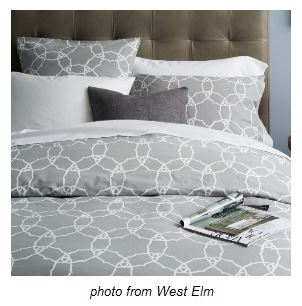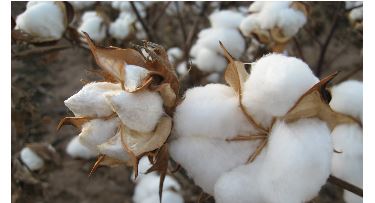This post may contain affiliate links. Read our disclosure here.

Recently, I was shopping around for some new bedding to replace my old bedding with “kid art” all over it. I found a print that I liked on sale, and it was even organic cotton. Honestly, organic cotton hasn’t been on my “must have” list for bedding; it has been a “nice to have” feature. I’ve never prioritized organic textiles before for the obvious reason: you don’t eat it. The truth is, I’ve never really looked into it before. Do organic fabrics make a difference? Should you be prioritizing organic cotton fabric?

What is Organic Cotton?
 Cotton is a unique crop. It can be use as a food (cottonseed oil), an animal feed, and as a fiber for fabric and other products. Much like other organic crops, organic cotton must be grown from a non-GMO seed and without synthetic/toxic fertilizers and pesticides. That’s the basics. After the cotton is grown, “organic” can mean a lot of different things. If you’re shopping around for organic sheets or clothing, you’ll want to know a little bit more about the product: is it 100% organic cotton? Is it a blend? Is it certified? What about the dyes and manufacturing process?
Cotton is a unique crop. It can be use as a food (cottonseed oil), an animal feed, and as a fiber for fabric and other products. Much like other organic crops, organic cotton must be grown from a non-GMO seed and without synthetic/toxic fertilizers and pesticides. That’s the basics. After the cotton is grown, “organic” can mean a lot of different things. If you’re shopping around for organic sheets or clothing, you’ll want to know a little bit more about the product: is it 100% organic cotton? Is it a blend? Is it certified? What about the dyes and manufacturing process?
Conventional Cotton, Pesticides, and GMOs
Cotton is grown in 20 countries worldwide, led by India, with a decent percentage being grown in the United States. Cotton alone accounts for over 14% of all insecticide sales worldwide. One crop accounts for 14% of all insecticide sales? Yes. Cotton is a heavily sprayed crop. In the 2010, the U.S. alone used 45 million pounds of pesticides, just for its cotton crops. Why?
Cotton has one of the most expensive pests around, the cotton boll weevil. This little bug is infamous for creating the greatest crop cash losses in history. In attempts to squash this bug’s impact, the misuse of pesticides on cotton has caused its own damage, often eliminating beneficial insects and letting other pests rise up in their place. In 1995, $150 million of cotton crops were lost due to overuse/misuse of malathion insecticide.
The heavy pesticide use on cotton takes its toll on the environment, surrounding areas, and the workers. The pesticides leach and run-off, entering the groundwater. Synthetic, nitrogen-based fertilizers increase N2O emissions (a greenhouse gas 300x more potent than CO2). Workers are exposed to the pesticides with 83% of exposure cases exhibiting symptoms of mild to severe poisoning.
There are dozens of different pesticides used on cotton…dozens. Over twenty of these pesticides are considered:
Possible, likely, probable, or known human carcinogens by the EPA
Moderately to highly hazardous by the World Health Organization
Known endocrine disruptors linked to Parkinson’s, Alzheimer’s, diabetes, cardiovascular disease, early puberty, obesity, infertility, and cancers
Worldwide, over 93% of all conventional cotton is grown from genetically modified seed, Bt Cotton. This GMO seed produces an insecticide to kill pests like the boll weevil larvae.
Organic Certification
There are two reigning certifications for organic cotton, and it can be a little confusing because of the many ways cotton is used: food, feed, or fiber.
1. The USDA NOP (U.S. Department of Agriculture National Organic Program) is a government organization that certifies the raw cotton material. This means that the seed and growing practices all adhere to the organic standards. From here, organic cotton will continue along the food/feed track or head for textile processing.
2. The GOTS (Global Organic Textile Standard) is a third-party organization that regulates the processing of organic fibers. They examine the entire supply chain (harvesting, processing, manufacturing, and labelling), looking at both ecological criteria and social criteria.
“Organic” Cotton Labelling: Know What You’re Buying
 You can buy products made with organic cotton, but unless it is certified by GOTS, all you know is that the fiber portion labelled “organic cotton” was grown organically. A product with GOTS certification tells you a lot more.
You can buy products made with organic cotton, but unless it is certified by GOTS, all you know is that the fiber portion labelled “organic cotton” was grown organically. A product with GOTS certification tells you a lot more.
GOTS Environmental Criteria Includes:
chemicals used (including dyes) meet their standards for toxicity and biodegradability
no heavy metals, formaldehyde, or GMOs
no chlorine bleaching
printing free of phthalates and PVC
all wastewater treated in a water treatment plant
packaging is PVC-free
quality meets criteria for rubbing, washing, and shrinkage
products are tested for pesticide residue, checking for contamination
GOTS Social Criteria Includes:
employment is freely chosen
working conditions are safe
no child labor
workers are paid a living wage
non-excessive work hours
harsh or inhumane treatment is prohibited
GOTS offers two tiers of labelling. “Organic” means that 95+% of that fabric is made with certified organic fibers. “Made with x% Organic” means that 70+% of that fabric is made with certified organic fibers. This sounds very similar to the organic food labelling laws. When shopping for organic cotton products, check the tag for the GOTS symbol.
Conventional Cotton: Is It a Concern?
Do all those pesticides sprayed on the cotton crop really make it into your fabric?
Maybe. A study tested conventional cotton fabrics and found residues of hexachlorobenzene, aldrin, dieldrin, and DDT pesticides, all classified as “probable human carcinogens” by the EPA. However, most cotton fabrics intended for clothing are treated to remove the pesticides. Cotton intended for other uses, including batting for bedding and mattresses, is not stripped of pesticides.
In my opinion, pesticides aren’t the biggest safety concern. The conventional fabric manufacturing process introduces several chemicals, each with their own toxicity concerns: chlorine bleaches, heavy metals, petroleum-based dyes, formaldehyde, and PVC and phthalates plastics. These chemicals are not easily removed and are released/exposed with wear.
Should Organic Cotton Be a Priority?
-It depends.
-Do you feel strongly about “voting with your dollars”? Then, yes, choose organic cotton to support organic farming.
-Do you feel strongly about the environmental impact? Then you should definitely prioritize organic cotton. The conventional cotton farming practices have a serious, negative effect on our water, air, and soil.
-Do you have sensitive individuals (babies, children, immunocompromised) that would benefit from reduced chemical exposure? Choose GOTS certified organic products or research companies that do not use toxic chemicals to produce their products.
-Are you buying an cotton blanket or mattress? Any product made with cotton batting doesn’t have to have the pesticides removed. You’re getting a double dose of chemicals, unless you buy organic.
Perspective
After learning more about the cotton industry, I’ll definitely be reading more clothing labels and looking for products with GOTS certifications. Will I exclusively buy organic cotton? Probably not. It’s not on my priority list, but it is on my radar. If I can buy an organic cotton product for the same or similar price as the conventional product, I will.
Are you shopping around for some organic sheets? I’ve found some good deals on GOTS certified products on Amazon.com, The Company Store (sale section), and West Elm’s sale section (where I bought my organic duvet cover). I’ve looked at the organic cotton bedding at Target but didn’t see a GOTS certification. Do you have any good sources to share?
What are your thoughts about organic cotton fabric? Will it make your priority list?
This is part of an Organic Living Journey Guest Post Series now written by Mariana who has a mother’s heart and scientist’s brain.


